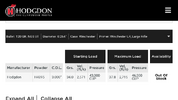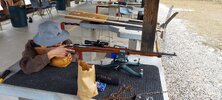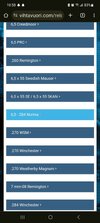The thing to remember, Swedish Mausers were made out of plain carbon steels for a round that had a maximum specified pressure of 3000 atmospheres. About 43,300 pounds per square inch. The steels used are much weaker than modern alloy steels, and carbon steels have a history of breaking without warning. Carbon steels take less energy to break a low temperatures, and their fatigue life is less. They were however, cheap, and a known quantity in the 1890's. The Swedes being conservative and loathe to change, never used more advanced steels, even through WW2. Early receivers are to be considered of lower metallurgical quality than later, just due to the in process control technologies. Higher pressure loads have set receiver seats back and caused receiver rings to fragment. I am going to claim 308 Win conversions on Swedish Mausers are dangerous, and a bomb waiting to go kaboom. The round primarily got excellent velocity because the infantry rifle had a 29 inch barrel.
In a 1950's American Rifleman magazine, a 140 grain bullet with 43.0 grains IMR 4350 was declared to be a service rifle equivalent load. That load has been my "standard" till I found IMR 4831/H4831. My velocity standard has been taken from actual service rifle rounds. This is not exact as old gunpowder actually increases in pressure, but if mine is still"good", then the velocities are valid.
M1896 Infantry Rifle 29' barrel Carl Gustafs mfgr 1903
17-Aug-06 T = 85 °F
143 gr FMJ 1986 Swedish Ball
Ave Vel = 2610
Std Dev = 14.38
ES = 45.59
High = 2633
Low = 2587
N = 8
M38 Infantry Carbine 24" barrel
28-Oct-94 T ? 60 °F
143 gr 1986 Swedish Ball OAL 3.065" 47.4 grs powder average
Ave Vel = 2427
STD=22
ES = 62
Low = 2395
High = 2457
Number rounds= 10
Code:
M700 22" Barrel
143 gr Swedish Ball 1986 headstamp
2 Feb 2008 T = 54 °F
Ave Vel =2470
Std Dev =18
ES =48
High =2491
Low =2443
N =5
140 gr Hornady Spire Point 43.0 grs AA4350 R-P new brass CCI-200 OAL 2.990"
2 Feb 2008 T = 52 °F
Ave Vel = 2512
Std Dev = 27
ES = 72
High = 2547
Low = 2475
N = 5
140 gr Hornady Spire Point (0.264") 43.0 grs AA4350 new R-P cases CCI 200 OAL 2.990" loaded 2-5-2000
2 Nov 2017 T=72 °F
Ave Vel =2531
Std Dev =14
ES =33
High =2540
Low =2507
N=5
140 gr Hornady SP greased 45.0 grs IMR 4831 wtd lot 2-22-2014 new R-P cases CCI 200 OAL 3.065"
2 Nov 2017 T=72 °F
Ave Vel = 2548
Std Dev =11
ES =28
High =2566
Low =2538
N =5
140 gr Hornady SP greased 45.0 grs H4831 wtd lot 01-06-2014 new R-P cases CCI 200 OAL 3.065"
2 Nov 2017 T=72 °F
Ave Vel = 2419
Std Dev = 31
ES = 88
High = 2477
Low = 2389
N = 8

Same day, same ammunition, different barrel, velocities will be different.
Code:
Winchester M70 Featherweight 22" Barrel
143.5 gr FMJBT Swedish 1986 ball. OAL 3.065" 47.4 grs powder average
13 Oct 2017 T=72 °F
Ave Vel = 2460
Std Dev = 21
ES = 30
High = 2474
Low = 2444
N = 5
Very good group
140 gr Hornady Spire Point 43.0 grs AA4350 R-P new brass CCI-200 OAL 2.990"
18 Nov 2007 T = 75 °F
Ave Vel = 2428
Std Dev = 29
ES = 95
High = 2480
Low = 2385
N = 24
easy bolt life, nice rounded primers
140 gr Hornady Spire Point (0.264") 43.0 grs AA4350 new R-P cases CCI 200 OAL 2.990"
loaded 2-2000
13 Oct 2017 T=72 °F
Ave Vel = 2387
Std Dev = 23
ES = 67
High = 2424
Low = 2357
N = 15
Best group of all reloads
140 gr Hornady Spire Point Flat Base (0.264") 43.0 grs AA4350 new R-P cases CCI 200 OAL 2.990" loaded 2-5-2000
2 Nov 2017 T=72 °F
Ave Vel = 2413
Std Dev = 17
ES = 50
High = 2441
Low = 2391
N = 6
140 gr Hornady SP greased 45.0 grs IMR 4831 wtd lot 2-22-2014 new R-P cases CCI 200 OAL 3.065"
2 Nov 2017 T=72 °F
Ave Vel = 2419
Std Dev = 19
ES = 43
High = 2439
Low = 2396
N = 5
140 gr Sierra Matchking greased 45.0 grs IMR 4831 wtd lot 2-22-2014 new R-P cases CCI 200 OAL 3.065"
2 Nov 2017 T=72 °F
Ave Vel = 2438
Std Dev = 12
ES = 30
High = 2448
Low = 2418
N = 5
140 gr Hornady SP (0.264") greased 47.0 grs IMR 4831 wtd lot 282 NNY cases Fed 210S OAL 3.050"
13 Oct 2017 T=72 °F
Ave Vel = 2633
Std Dev = 24
ES = 81
High = 2680
Low = 2599
N = 10
140 gr Hornady SP (0.264") greased 48.0 grs IMR 4831 wtd lot 282 NNY cases Fed 210S OAL 3.050"
13 Oct 2017 T=72 °F
Ave Vel = 2688
Std Dev = 16
ES = 44
High = 2705
Low = 2661
N = 10
Overmax load, primer cupping around firing pin, shiny rub marks on case heads
140 gr Hornady SP greased 45.0 grs H4831 wtd lot 01-06-2014 new R-P cases CCI 200 OAL 3.065"
2 Nov 2017 T=72 °F
Ave Vel = 2289
Std Dev = 9
ES = 16
High = 2296
Low = 2280
N = 5

This cartridge is at its best with slow burning powders, therefore I did not test faster burning. But if you are going to use a 4895, don't push velocities. Stay at least within Swedish velocities, under the assumption, the pressures will be safe. I don't see any reason to go heavier than a 140 grain bullet in this cartridge.
The Swedish round is an excellent one, and because of its increased case capacity over the 6.5 Creedmore, it will push a bullet faster, at the same pressures. I knew one Highpower shooter who had a single shot M700 chambered in 6.5 Swede that he used in long range competition. The 308 Win sized action was only usable as a single shot. The primary reasons the cartridge did not take over the firing line in the US were 1) the round was too long for a 308 Win magazine, and 2) good target 6.5 caliber bullets did not start appearing till the mid 1990's. During the post WW2 period to 1968, when the Army wrote the NRA Highpower rules, there might have been 30-06 and 308 Win only requirements. However, I say from mid 1990's onward, when good 6.5 grain target bullets were easy to find, cartridges such as the 6.5-08 and 6.5 wildcats started appearing on the firing line, and they were shooting knots, with very little windage and elevation required! The things were flat. At 600 yards, my 308 rounds crested at the top of the target before hitting center. The 6.5 rounds were cresting somewhere in the black. And at 1000 yards, 6.5 caliber bullets were incredibly flat compared to the 308 bullets I was using. My 308 bullets, you could pick up the trace multiple target diameters as they dropped in. The 6.5's a little above the target.







